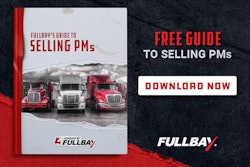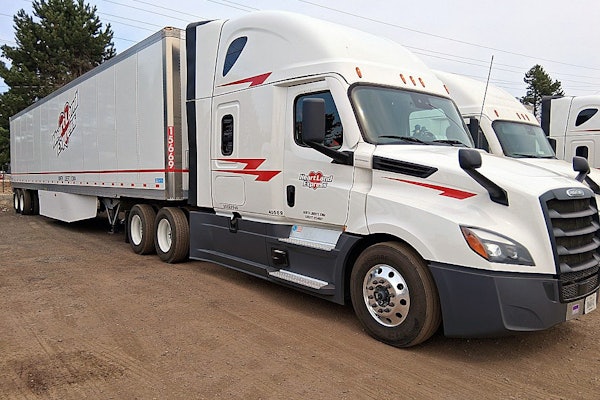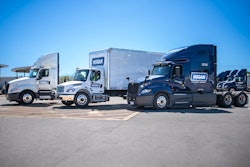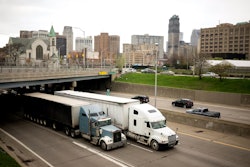Freightliner will transfer selected functions from its corporate headquarters in Portland, Ore., to a South Carolina location closer to customers and Freightliner Trucks production facilities. Company officials confirmed that 341 positions are affected, including Freightliner Trucks sales and marketing functions.
Ryder System launched its RydeGreen line of tractors and trailers designed to reduce fuel consumption and greenhouse gas emissions. The line features equipment that has been
certified by the SmartWay Transport Partnership, an initiative of the Environmental Protection Agency and the transportation industry.
The Boler Company signed a definitive agreement to acquire Watson and Chalin Manufacturing, a manufacturer of truck and trailer suspension systems. Both Hendrickson and Watson and Chalin will be standalone companies under The Boler Company organization.
Isuzu Commercial Truck of America announced the availability of what it says is the industry’s first gas-powered low-cab-forward crew-cab truck. The new model features a Vortec 6.0L V8 engine with 325 hp, and a Hydra-Matic 4-speed automatic transmission with lockup torque converter and overdrive.
ArvinMeritor said last month it plans to begin production by May at a new Commercial Vehicle Systems (CVS) facility in Monterrey, Mexico, providing about 400,000 square feet of manufacturing and office space for the company’s axle and brake assembly operations and component manufacturing. The company’s CVS axle operation in Arden, N.C., is expected to close by next September.
Utility Trailer Manufacturing Co. said that its plant in Paragould, Ark., reached a production milestone with its 75,000th dry van that rolled off the assembly line in August. The plant builds the 4000D-X dry van, which accounted for more than 50 percent of Utility’s dry van production in 2006.
Caterpillar Inc. said it had received a J.D. Power and Associates Award for ranking highest in customer satisfaction for its pickup-and-delivery heavy-duty diesel engines as part of the 2007 Heavy-Duty Truck Engine/Transmission Study.
Kenworth received a FedEx Freight Outstanding Performance Award based on its performance during the past fiscal year.
Bendix Commercial Vehicle Systems celebrated the 5,000th download of its ACom diagnostics software. The company also is among the organizations speaking out in support of new legislation that would provide tax incentives for the implementation of commercial vehicle safety technologies.
Manac Inc. named Bridgestone Firestone North American Tire the primary tire supplier for Manac and its CPS Trailer brand in North America.
Penske Truck Leasing celebrated the grand opening of its new $7.6 million 14,000-square-foot facility in Portland, Ore.
Luber-finer, a division of Champion Laboratories, has added a Web page that focuses on its recently debuted Oil Analysis Program. Visit www.luberfiner.com/products/labanalysis.html.
Delphi Product & Service Solutions will launch Diesel Point, a new initiative that ensures independent automotive garages benefit fully from available opportunities in the service of diesel vehicles.
The Denso North America Foundation pledged to donate $200,000 to the American Red Cross for California wildfire disaster relief.
International Truck and Engine Corp. announced Oct. 31 that its MaxxForce diesel engines will meet the Environmental Protection Agency’s 2010 emissions standards for all its core applications without the use of selective catalytic reduction (SCR) technology. Instead, International plans to address emissions requirements through an advanced fuel system, air management, combustion and controls.
“I have publicly been an advocate of customer-friendly emissions control solutions which do not add additional costs to our truck and bus customers,” says Daniel Ustian, chairman and chief executive of International parent Navistar. “While SCR is a means to achieve the NOx reduction requirement for 2010, it comes with a steep cost to our customers. Our ability to achieve our goals without adding customer cost and inconvenience is a competitive advantage for International.”
“This approach will best serve our core customers who value reduced product and service complexity, as well as business-planning continuity through another period of industry uncertainty,” says Jack Allen, president of International Engine Group.
International, which will introduce the 2007-technology MaxxForce in the next couple of months, is the second “big bore” engine maker to declare a 2010 emissions solution that does not involve neutralizing NOx by introducing urea as a catalyst in the exhaust system.
Cummins in September said it would achieve requirements through a combination of the XPI high-pressure common rail fuel system, improved cooled exhaust gas recirculation (EGR), advanced electronic controls, variable geometry turbochargers and the Cummins diesel particulate filter. (See “No urea needed,” Equipment, October 2007.) Cummins is using SCR technology in its medium-duty engines, however.
International begins hybrid production
International Truck and Engine Corp. announced last month that it had begun production of hybrid commercial trucks – specifically the medium-duty International DuraStar Hybrid. The company says the truck can save 30 to 40 percent on fuel in a standard in-city pickup-and-delivery application. Fuel savings can be even greater in utility-type operations, where electricity – rather than an engine power-takeoff – can power overhead booms, International says.
“In our continued quest to be the first to market with new truck technologies, we are taking the next major step in bringing a medium-duty diesel hybrid-electric vehicle into the marketplace,” says Dee Kapur, president of International’s Truck Group.
In 2006, International built 24 developmental hybrid units and delivered them to 14 major utility companies across North America. As part of the development process, International has worked with the Hybrid Truck Users Forum (HTUF), a consortium of utility industry customers, Eaton Corp., the Westart/Calstart organizations and the U.S. government. The collaboration helped International bring the technology to market and provided direct customer feedback, says Jim Williams, International’s director of sales and distribution for new products. “The prototype phase is done – International is now building hybrid trucks.”
HTUF estimates that nearly 1,000 gallons of fuel can be saved annually on utility trucks. A big challenge, International concedes, is the high initial cost of a hybrid today. Those costs likely will decline as production grows, and federal tax credits – up to $12,000 per unit was authorized by the Energy Policy Act of 2005 – can help.
Michelin keepin’ it green
Michelin North America’s chairman and president Jim Micali announced an initiative designed to reduce tire-related fuel consumption for each vehicle to half of what it is now by 2030 – the year when the number of vehicles worldwide is projected to have doubled. The announcement was part of an event held at New York’s NASDAQ MarketSite Studio.
Micali touted the Michelin Energy Saver tire, a European passenger tire that reduces carbon-dioxide emissions by 3 percent; and the X One wide-single truck tire that “converts 18-wheelers to 10-wheelers by replacing two dual tires with one wide single. Micali says. “Michelin X One tires save 4 percent in fuel economy and reduce the weight of a tractor-trailer by up to 720 pounds,” which ultimately could allow for more payload per vehicle – and mean fewer tractor-trailers on the road.
– John Baxter
CARB approves Webasto heaters
No APUs have been verified to date
The California Air Resources Board (CARB) has verified three Webasto Product North America heating products – the Webasto Air Top 2000 S and Air Top 2000 ST compartment air heaters and Thermo Top Z/C (TSL 17) engine coolant pre-heater. The three Webasto heaters join three Espar heaters – Airtronic D2, Airtronic D4 and Hydronic 5 – as the only diesel-fired heaters verified for emissions requirements when installed on trucks powered with model 2007 or later diesel engines.
In addition to diesel heaters, diesel-fueled auxiliary power units (APUs) must be verified if they are to be used on trucks powered with model 2007 or later diesel engines. As of Nov. 21, CARB has yet to verify any diesel APUs. For an up-to-date list of verified equipment, go to www.arb.ca.gov/noidle.
This thing learns fast!
A transmission that’s smarter than your drivers
While passenger cars with standard transmissions usually will beat out similarly equipped cars with automatics, the same is not necessarily true of trucks.
“The real difference is that, with manuals and automated manuals, every time you shift, you’re separating the engine from the transmission,” says Bruce McCammon, product-training instructor at Allison Transmission. Every time you shift, you’ve got a loss of power; the truck loses momentum and turbo boost, and therefore is wasting fuel. And it doesn’t matter how good and how fast a shifter you are. With an automatic, there is no loss of power because the engine and transmission always are connected through the torque converter.
“The Allison Transmission Fourth Generation Electronic Controls have one 80-way connector versus the two or three from our previous models,” McCammon says. Communication is the name of the game with this system, he says.
The speed sensor at the front reads engine speed. The one in the middle reads turbine speed, and the speed sensor at the rear reads the output shaft speed. “So, between these three speed sensors, we know input, output and everything in the middle,” McCammon says. “Ratio-wise, the computer can detect the actual mechanical ratio versus electronic asked-for information. The computer knows what a perfect shift is. And if that perfect shift doesn’t happen, it will adapt. It’s called Adaptive Control, and it is working all of the time. All of our 1000-4000 transmissions have it.”
For instance, consider a construction truck that’s full vs. empty, manned by different drivers and perhaps equipped with worn parts – the computer will compensate for these conditions and adjust the shift. Allison reportedly uses speed sensor data along with throttle position and shift selector information to calculate the best shifting parameters possible. So if a driver detects a “not-so-perfect shift,” McCammon says, he need only wait for that same shift to occur again, and he’ll probably notice that it starts to smooth out.
– Paul Richards
Keeping your techs on top
Delmar Cengage Learning, a provider of training and information materials, announced the expansion of its Professional Technician Training Series that now offers interactive self-paced training in both the automotive and medium-/heavy-duty truck training areas.
The courses are available in both CD-ROM and Web-based formats. These courses focus on engaging technicians and optimizing information retention through the use of animations and interactivities. The series covers topics ranging from electricity and electronic systems to preventive maintenance, with each course containing the most up-to-date theory, application and diagnostic materials.
The courses follow the competency guidelines as set forth by both the National Automotive Technicians Education Foundation (NATEF) and the National Institute for Automotive Service Excellence (ASE). Moreover, to ensure that the material is understood and retained, each course contains end-of-section review questions, as well as a comprehensive review at the end of the course, awarding a printable certificate of completion to each user who achieves a score of 80 percent or higher.
EquipmentPuzzler
Back in October, we asked: In a hydraulic disc brake system, if the master cylinder has a 1-inch bore and produces 700 lb of force, how much force will a single-piston caliper exert on the brake pads, if said piston has a 2-inch bore?
The answer, 1, 400 lb of force, was not supplied by a reader. The force generated would be the product of initial force, as determined by the bore at the master cylinder and pedal leverage, times the area of the bore at a slave cylinder, i.e. 700 x 2 = 1,400.
No need to “brake” a sweat. You can receive an elegant CCJ pen and Air Brake Book if you’re the first to e-mail [email protected] with the correct answer to this month’s Puzzler, or send in a Puzzler of your own. If we use it, you win.
This month’s Puzzler: In early posters of Bib, the “betired” Michelin man, he’s seen raising a glass of nails and glass, proclaiming “Nunc est bibendum.” What does that mean?










